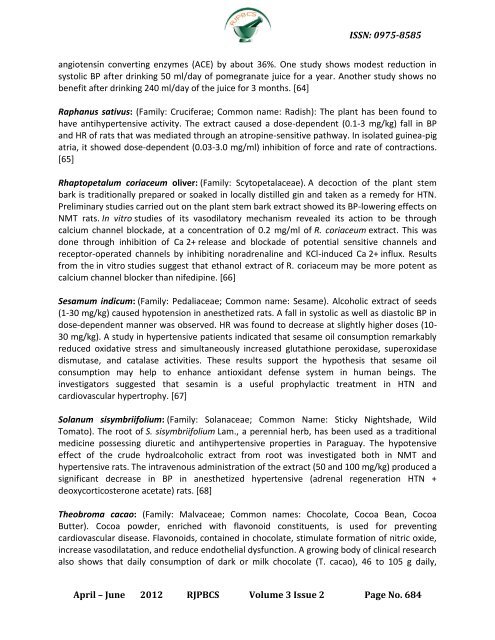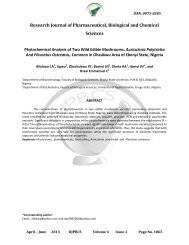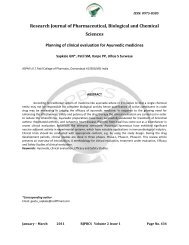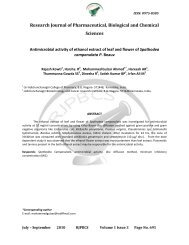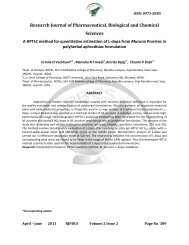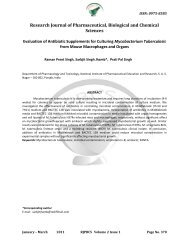Research Journal of Pharmaceutical, Biological and ... - RJPBCS
Research Journal of Pharmaceutical, Biological and ... - RJPBCS
Research Journal of Pharmaceutical, Biological and ... - RJPBCS
Create successful ePaper yourself
Turn your PDF publications into a flip-book with our unique Google optimized e-Paper software.
ISSN: 0975-8585<br />
angiotensin converting enzymes (ACE) by about 36%. One study shows modest reduction in<br />
systolic BP after drinking 50 ml/day <strong>of</strong> pomegranate juice for a year. Another study shows no<br />
benefit after drinking 240 ml/day <strong>of</strong> the juice for 3 months. [64]<br />
Raphanus sativus: (Family: Cruciferae; Common name: Radish): The plant has been found to<br />
have antihypertensive activity. The extract caused a dose-dependent (0.1-3 mg/kg) fall in BP<br />
<strong>and</strong> HR <strong>of</strong> rats that was mediated through an atropine-sensitive pathway. In isolated guinea-pig<br />
atria, it showed dose-dependent (0.03-3.0 mg/ml) inhibition <strong>of</strong> force <strong>and</strong> rate <strong>of</strong> contractions.<br />
[65]<br />
Rhaptopetalum coriaceum oliver: (Family: Scytopetalaceae). A decoction <strong>of</strong> the plant stem<br />
bark is traditionally prepared or soaked in locally distilled gin <strong>and</strong> taken as a remedy for HTN.<br />
Preliminary studies carried out on the plant stem bark extract showed its BP-lowering effects on<br />
NMT rats. In vitro studies <strong>of</strong> its vasodilatory mechanism revealed its action to be through<br />
calcium channel blockade, at a concentration <strong>of</strong> 0.2 mg/ml <strong>of</strong> R. coriaceum extract. This was<br />
done through inhibition <strong>of</strong> Ca 2+ release <strong>and</strong> blockade <strong>of</strong> potential sensitive channels <strong>and</strong><br />
receptor-operated channels by inhibiting noradrenaline <strong>and</strong> KCl-induced Ca 2+ influx. Results<br />
from the in vitro studies suggest that ethanol extract <strong>of</strong> R. coriaceum may be more potent as<br />
calcium channel blocker than nifedipine. [66]<br />
Sesamum indicum: (Family: Pedaliaceae; Common name: Sesame). Alcoholic extract <strong>of</strong> seeds<br />
(1-30 mg/kg) caused hypotension in anesthetized rats. A fall in systolic as well as diastolic BP in<br />
dose-dependent manner was observed. HR was found to decrease at slightly higher doses (10-<br />
30 mg/kg). A study in hypertensive patients indicated that sesame oil consumption remarkably<br />
reduced oxidative stress <strong>and</strong> simultaneously increased glutathione peroxidase, superoxidase<br />
dismutase, <strong>and</strong> catalase activities. These results support the hypothesis that sesame oil<br />
consumption may help to enhance antioxidant defense system in human beings. The<br />
investigators suggested that sesamin is a useful prophylactic treatment in HTN <strong>and</strong><br />
cardiovascular hypertrophy. [67]<br />
Solanum sisymbriifolium: (Family: Solanaceae; Common Name: Sticky Nightshade, Wild<br />
Tomato). The root <strong>of</strong> S. sisymbriifolium Lam., a perennial herb, has been used as a traditional<br />
medicine possessing diuretic <strong>and</strong> antihypertensive properties in Paraguay. The hypotensive<br />
effect <strong>of</strong> the crude hydroalcoholic extract from root was investigated both in NMT <strong>and</strong><br />
hypertensive rats. The intravenous administration <strong>of</strong> the extract (50 <strong>and</strong> 100 mg/kg) produced a<br />
significant decrease in BP in anesthetized hypertensive (adrenal regeneration HTN +<br />
deoxycorticosterone acetate) rats. [68]<br />
Theobroma cacao: (Family: Malvaceae; Common names: Chocolate, Cocoa Bean, Cocoa<br />
Butter). Cocoa powder, enriched with flavonoid constituents, is used for preventing<br />
cardiovascular disease. Flavonoids, contained in chocolate, stimulate formation <strong>of</strong> nitric oxide,<br />
increase vasodilatation, <strong>and</strong> reduce endothelial dysfunction. A growing body <strong>of</strong> clinical research<br />
also shows that daily consumption <strong>of</strong> dark or milk chocolate (T. cacao), 46 to 105 g daily,<br />
April – June 2012 <strong>RJPBCS</strong> Volume 3 Issue 2 Page No. 684


